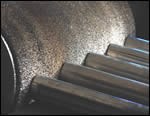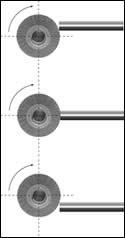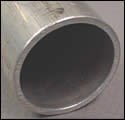Selecting Brushes For Burrs
Deburring is often a practical necessity after cutoff operations. Wire brush systems provide a low-cost and reliable means of automatic deburring of barstock or tube stock.
Deburring is often a practical necessity after cutoff operations. Wire brush systems provide a low-cost and reliable means of automatic deburring of barstock or tube stock. They can be an ideal solution for cutoff applications that require deburring, but do not need the end finishing of a chamfering blade. Wire brush deburring systems are considerably less expensive to purchase and operate than chamfering machines, and quality brushes last much longer than cutting inserts on double-end finishers.
Manufacturers often choose brush deburring because it does not change the tube dimensions. Even thin-wall tubing can be deburred without altering concentricity. Unlike chamfering processes, brush deburring will not leave secondary micro burrs. Brush deburring is also more forgiving than chamfering with a blade, tolerating some imprecision in tool setup and slight variations in machine alignment and tube length.
Automated brushing systems can be integrated with cutoff operations to eliminate work-in-process and increase throughput. Cycle times of less than 5 seconds per piece can routinely be achieved.
Brush deburring can be applied to many different types and sizes of tubing, bars and extrusions. Brushes can deburr stock of almost any shape, material and end geometry. With brush deburring, it is also easy to quickly change from one configuration to another.
Most automated deburring processes employ two wide-face brushes set perpendicular to the stock, as shown in Figure 1. The brushes deburr both ends simultaneously. The rotation of the brush is clockwise at one end and counterclockwise at the other end, so that the brushes move across both ends in a downward direction.
The stock is held in carriers and rotated via sprockets and chains at a constant rate as they travel by the brush media. The rotation of the stock allows for the entire circumference of the edges to be brushed evenly and deburred. The position of the brushes can be adjusted horizontally for different lengths and to set the pressure and penetration of the deburring action.
For tube stock, vertical positioning determines which edges of the tube are deburred, as shown in Figure 2. If the center of the brush and the center of the tube are horizontally aligned, then both the interior and exterior edges of the tube will be deburred. If the center of the brush is set above the tube, only the exterior edge will be deburred. Likewise, if the center of the brush is set below the tube, only the interior edge will be in contact with the brush.
High brush speed is critical to application success. Wire brushes work by delivering millions of wire tips to the burred edge each minute. These wire tips have a hardness of approximately 60 Rc and a striking velocity of more than 60 mph. This high-impact action separates the burr from the stock and leaves a smooth edge. The recommended rotational speed depends on the stock diameter: 3,450 rpm for brushes with an OD of 6 to 8 inches, 2,750 rpm for brushes with an OD of 10 to 12 inches, and 1,750 rpm for brushes with an OD of 14 to 16 inches.
The high brush speed allows the system to perform with lower brush operating pressure and penetration. Excessive pressure and penetration prevents the wire tips from contacting the edge and causes filament breakage. The result is a reduction in brush life and deburring action.
Feed rate is dictated by the nature of the burrs to be removed. Heavier burr necessitates the removal of more material, and therefore, may require a longer time in front of the brushes. Lighter burr requires less time in front of the brushes. Adjustable feed rate allows the system to achieve an optimal combination of deburring action, throughput and brush life. Optimal matching of the brush to an application can extend brush life by three or four times.
Choosing a brush that matches the particular application can be a challenge, because five variables must be addressed: brush diameter, brush length, wire size, type of wire and brush density.
Brush Diameter.
Brush diameter is determined by the diameter of the stock to be processed. Since radius of curvature changes with brush diameter, larger brushes are required to deburr larger stock. If the OD is less than 1 inch, the brush should typically have a diameter of 10 inches. For stock with an OD larger than 3 inches, a 15- to 16-inch brush is usually recommended.
Brush Length.
The length of the brushes needs to be sufficient to allow three full rotations of the stock in the brush. This means that the minimum brush length can be calculated by multiplying the stock diameter by 9.45 (i.e., Pi multiplied by 3 for the three rotations).
Wire Size.
The size of the wires in the brush is based upon the size of the burrs. Average cutoff burrs, labeled Class Four burrs, are relatively large protrusions attached by thick roots. They often can be removed with 0.014-inch wire. Class Three burrs are characterized by moderate size and thin roots, and they can be easily removed by finer wires between 0.008 and 0.0118 of an inch. Large burrs in the Class Five category can sometimes be removed with 0.020-inch wire. However, in some cases, these burrs must be removed using a metal removal operation like chamfering.
Wire Type.
Wire filaments can be steel or stainless steel. Stainless steel wire brushes are recommended for applications on stainless, aluminum and other nonferrous tube materials. Using steel brushes on these materials will cause “after-rust,” which results from contamination of the worked area with ferrous particles.
Brush Density.
Wire density refers to the number of wires packed into a square inch of brush surface area. Higher brush density increases brush life and deburring action. For some applications, it is cost-effective for users to pay a premium for high-performance brushes with high-brush density. For other applications, economy brushes with one third the density are preferred. Users need a range of brush density to choose from to optimize the economics of their specific process.
For good performance and brush life, the ends of the stock should penetrate into the brush face less than 1/8 inch, a requirement that necessitates a stable center of rotation. To ensure good balance, quality brush manufacturers will distribute filaments evenly and then test the balance during rotation, adding weights if necessary, in a process comparable to how automobile mechanics balance wheels.
Brush systems offer a low-cost and reliable method of deburring cutoff stock. By selecting high-quality brushes that are balanced and closely match the five parameters of their particular application, users can expect long brush life and trouble-free operation.
Read Next
Do You Have Single Points of Failure?
Plans need to be in place before a catastrophic event occurs.
Read More5 Aspects of PMTS I Appreciate
The three-day edition of the 2025 Precision Machining Technology Show kicks off at the start of April. I’ll be there, and here are some reasons why.
Read MoreA Tooling Workshop Worth a Visit
Marubeni Citizen-Cincom’s tooling and accessory workshop offers a chance to learn more about ancillary devices that can boost machining efficiency and capability.
Read More















.jpg;maxWidth=300;quality=90)





